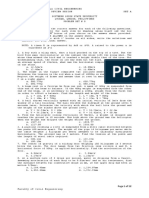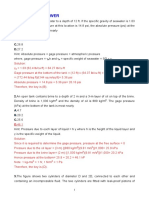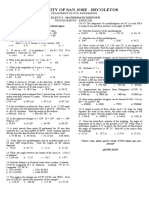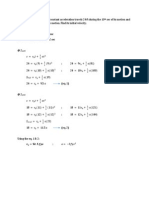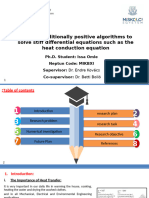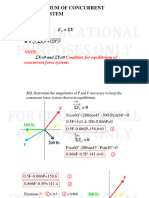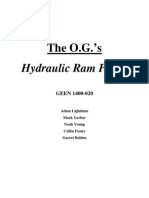Dynamics
Uploaded by
Jan Roald Buemia TriumfanteDynamics
Uploaded by
Jan Roald Buemia Triumfante1
Rectilinear Motion with Constant Acceleration
1. On a certain stretch of track, trains run at 60
mph. How far back of a stopped train should a
warning torpedo be placed to signal an oncoming
train? Assume that the brakes are applied at once
and retard the train at the uniform rate of 2 ft per
sec
2
.
2. A stone is thrown vertically upward and
returns to earth in l0sec. What was its initial
velocity and how high did it go?
3. A ball is dropped from the top of a tower 80 ft
high at the same instant that a second ball is
thrown upward from the ground with an initial
velocity of 40 ft per see. When and where do they
pass, and with what relative velocity?
4. A stone is dropped down a well and 5 sec later
the sound of the splash is heard. If the velocity of
sound is 1120 ft per sec, what is the depth of the
well?
5. A stone is dropped from a captive balloon at an
elevation of 1000 ft. Two seconds later another
stone is projected vertically upward from the
ground with a velocity of 248 ft per sec. If g is 32
ft per sec
2
, when and where will the stones pass
each other?
6. A stone is thrown vertically upward from the
ground with a velocity of 48.3 ft per sec. One
second later another stone is thrown vertically
upward with a velocity of 96.6 ft per sec. How far
above the ground will the stones be at the same
level?
7. A ball is shot vertically into the air at a
velocity of 193.2 ft per sec. After 4 sec, another
ball is shot vertically into the air. What initial
velocity must the second ball have in order to
meet the first ball 386.4 ft from the ground?
8. A stone is thrown vertically up from the
ground with a velocity of 300 ft per sec. How
long must one wait before dropping a second
stone from the top of a 600-ft tower if the two
stones are to pass each other 200 ft from the top
of the tower?
9. A ship being launched slides down the ways
with a constant acceleration. She takes 8 sec to
slide the first foot. How long will she take to
slide down the ways if their length is 625 ft?
10. A train moving with constant acceleration
travels 24 ft during the 10th sec of its motion and
18 ft during the 12th sec of its motion. Find its
initial velocity and its constant acceleration.
11. An automobile starting from rest speeds up to
40 ft per sec with a constant acceleration of 4 ft
per sec
2
, runs at this speed for a time, and finally
comes to rest with a deceleration of 5 ft per sec
2
.
If the total distance traveled is 1000 ft, find the
total time required.
12. A train travels between two stations 1- mile
apart in a minimum time of 41 sec. If the train
accelerates and decelerates at 8 ft per sec
2
,
starting from rest at the first station and coming
to a stop at the second station, what is its
maximum speed in mph? How long does it travel
at this top speed?
13. Two cars A and B have a velocity of 60 mph
in the same direction. A is 250 ft behind B when
the brakes are applied to car B, causing it to
decelerate at the constant rate of 10 ft per sec
2
.
In what time will A overtake B, and how far will
each car have traveled?
14. An automobile moving at a constant velocity
of 45 ft per sec passes a gasoline station. Two
seconds later, another automobile leaves the
gasoline station and accelerates at the constant
rate of 6 ft per sec
2
. How soon will the second
automobile overtake the first?
15. A balloon rises from the ground with a
constant acceleration of 4 ft per sec
2
. Five
seconds later, a stone is thrown vertically up from
the launching site. What must be the minimum
initial velocity of the stone for it to just touch the
balloon? Note that the balloon and stone have the
same velocity at contact.
Rectilinear Motion with Variable Acceleration
Using Equations of Motions
1. The motion of a particle is given by the
equation
4 3 2
1
s 2t t 2t
6
, where s is in feet and
t in seconds. Compute the values of v and a when
t = 2 sec.
2. A particle moves in a straight line according to
the law s = t
3
- 40 t where s is in feet and t in
seconds.
(a) When t = 5 sec, compute the velocity.
(b) Find the average velocity during the fourth
second.
(c) When the particle again comes to rest, what is
its acceleration?
2
3. A ladder of length L moves with its ends in
contact with a vertical wall and a horizontal floor.
If the ladder starts from a vertical position and its
lower end A moves along the floor with a
constant velocity v
A
, show that the velocity of its
upper end B is v
B
= -v
A
tan where is the angle
between the ladder and the wall.
4. The rectilinear motion of a particle is given by
s = v
2
- 9 where s is in feet and v in feet per
second. When t = 0, s = 0 and v = 3 ft per sec.
Find the s-t, v-t, and a-t relations.
5. The velocity of a particle moving along the X
axis is defined by v = x
3
- 4x
2
+ 6 x where v is in
feet per second and x is in feet. Compute the
value of the acceleration when x = 2 ft.
6. The motion of a particle is defined by the
relation a = 4 t, where a is in feet per second
2
and
t in seconds. It is known that s = 1 ft and v = 2 ft
per sec when t = 1 sec. Determine the relations
between v and t, s and t, v and s.
7. The motion of a particle is governed by the
equation
2
8
a
s
, where a is in feet per second
2
and s is in feet. When t = 1 sec, s = 4 ft and v = 2
ft per Sec. Determine the relations between v and
t, s and t, v and s.
8. The motion of a particle is given by
1
2
a 6v ,
where a is in feet per second
2
and v in feet per
second. When t is zero, s = 6 ft and v = 0. Find
the relations between v and t, s and t, v and s.
9. The motion of a particle is governed by the
relation a = 4t
2
, where a is n feet per second
2
and
t is in seconds. When t is zero, v = 2 ft per sec
and s = 4 ft. Find the values of v and s when t = 2
sec.
Rectilinear Motion with Variable Acceleration
Using Motion Curves
1. From the v-t curve shown, determine the
distance traveled in 4 sec and also in 6 sec.
2. The motion of a particle starting from rest is
governed by the a-t curve shown. Determine the
displacement at t = 9 sec.
3. The curved portions of the v-t curve shown are
second degree parabolas with horizontal slope at t
= 0 and t = 12 sec. Determine the value of s when
t = 18 sec
4. A particle having an initial velocity of 200 ft
per sec decelerates according to the a-t curve
shown. Compute the change in displacement in
the time interval of 30 sec.
5. A car moving at 60 ft per sec is brought to rest
in 12 sec with a deceleration which varies
uniformly with time from 2 ft per sec
2
to a
maximum deceleration. Compute the distance
traveled in stopping.
6. A car starts from rest and reaches a speed of 48
ft per sec in 15 sec. The acceleration increases
from zero uniformly with time for the first 6 sec
after which it remains constant. Compute the
distance traveled in 15 sec.
7. A car accelerates for t sec from rest to a
velocity of 48 ft per sec, the acceleration
increasing uniformly from zero to 12 ft per sec
2
.
During the next 4 sec, the car decelerates at a
constant rate to a velocity of 4 ft per sec. Sketch
the a-t, v-t, and s-t curves.
3
8. An object attains a velocity of 16 ft per sec by
moving in a straight line with an acceleration
which varies uniformly from zero to 8 ft per sec
2
in 6 sec. Compute its initial velocity and the
change in displacement during the 6-sec interval.
9. The acceleration of an object decreases
uniformly from 8 ft per sec
2
to zero in 6 sec at
which time its velocity is 10 ft per see. Find the
initial velocity and the change in displacement
during the 6-sec interval.
Kinetics of Rectilinear Motion, Analysis as a
Particle
1. An elevator weighing 3220 lb starts from rest
and acquires an upward velocity of 600 ft per min
in a distance of 20 ft. If the acceleration is
constant what is the tension in the elevator cable?
2. A man weighing 161 lb is in an elevator
moving upward with an acceleration of 8 ft per
sec
2
.
(a) What pressure does he exert on the floor of
the elevator?
(b) What will the pressure be if the elevator is
descending with the same acceleration?
3. The block shown reaches a velocity of 40 ft
per sec in 100 ft, starting from rest. Compute the
coefficient of kinetic friction between the block
and the ground.
4. Determine the force P that will give the body
shown an acceleration of 6 ft per sec
2
. The
coefficient of kinetic friction is 0.20.
5. A magnetic particle weighing 3.6 grams is
pulled through a solenoid with an acceleration of
6 meters per sec
2
. Compute the force in pounds
acting on the particle.
6. When a 644-lb boat is moving at 10 ft per sec,
the motor conks out. How much farther will the
boat glide, assuming its resistance to motion is 2v
lb where v is in feet per second?
7. A bullet weighing 1 lb is fired vertically
upward with a muzzle velocity of 3000 ft per sec.
If the velocity is 2950 ft per sec after 1 sec, what
is the average air resistance on the bullet? What
maximum height will the bullet reach, assuming
that the air resistance remains constant?
8. Two blocks A and B are released from rest on
a 30 incline when they are 50 ft apart. The
coefficient of friction under the upper block A is
0.2 and that under the lower block B is 0.4.
Compute the elapsed time until the blocks touch.
9. Determine the acceleration of the bodies
shown if the fixed drum is smooth and A is
heavier than B.
10. Referring to Prob. 9, assume A weighs 200 lb
and B weighs 100 lb. Determine the acceleration
of the bodies if the coefficient of kinetic friction
is 0.10 between the cable and the fixed drum.
11. Two bodies A and B are separated by a
spring. Their motion down the incline is resisted
by a force P = 200 lb. The coefficient of kinetic
friction is 0.30 under A and 0.10 under B.
Determine the force in the spring.
12. If the pulleys shown are weightless and
frictionless, find the acceleration of body A.
4
13. Determine the acceleration of body B shown,
assuming the pulleys to be weightless and
frictionless.
14. The coefficient of kinetic friction under block
A is 0.30 and under block B it is 0.20. Find the
acceleration of the system and the tension in each
cord.
15. 1068. Determine the magnitude of W so that
the 200-lb body will have acceleration up the
plane of 4.025 ft per sec
2
.
16. Compute the acceleration of body B and the
tension in the cord supporting body A.
17. Compute the acceleration of body B and the
tension in the cord attached to it.
18. Compute the time required for the 100-lb
body to move 10 ft starting from rest.
19. If the pulleys are weightless and frictionless,
determine the acceleration of each weight in fps
2
.
20. Determine the acceleration of each weight
shown, assuming the pulleys to be weightless and
frictionless.
21. Determine the tension in the cord supporting
body C. The pulleys are frictionless and of
negligible weight.
5
22. In the system of connected blocks shown, the
coefficient of kinetic friction is 0.20 under bodies
B and C. Determine the acceleration of each body
and the tension in the cord.
23. Repeat Prob. 22, but change the weight of A
to 600 lb, of B to 1000 lb and of C to 500 lb.
24. Two blocks A and B, each weighing 96.6 lb
and connected by a rigid bar of negligible weight,
move along the smooth surfaces shown. They
start from rest at the given position. Determine
the acceleration of B at this instant.
Kinetics of Rectilinear Motion, Analysis as a
Rigid Body
1. A juggler places the lower end of a vertical
rod upon his finger. As it starts to tip, explain
how he keeps the rod in balance by moving his
finger horizontally back and forth.
2. The cable of a cargo crane can support a
maximum load of 2 tons. While the crane is
lowering a 1610-lb weight at uniform speed, the
brake on the winch is applied too rapidly, thereby
causing a sudden deceleration of the weight equal
to 100 fps
2
. The cable snaps and the weight falls,
badly injuring a workman. For the purpose of
establishing liability in this accident, is it likely
that failure of the cable was due to its being
weaker than its test strength of 2 tons? Why?
3. A uniform box is 2 ft square and 6ft high. It
stands on end upon a truck with its sides parallel
to the trucks motion. If the box weighs 240 lb
and the coefficient of friction between the box
and the truck is 0.30, show whether the block will
slide or tip first as the acceleration of the truck is
increased.
4. The uniform block shown weighs 200 lb. It is
pulled up the incline by the force P = 300 lb.
Determine the maximum and minimum values of
d so that the block does not tip over as it slides up
the incline. The coefficient of friction is 0.20.
Ans. Max. d = 2.32 ft; mm. d = 1.253 ft
5. The 240-lb body shown is supported by wheels
at B which roll freely without friction and by a
skid at A under which the coefficient of friction
is 0.40. Compute the value of P to cause an
acceleration of g.
6. If the value of P in Prob. 5 is 100 Ib, compute
the acceleration. If this value of P were applied at
a higher position on the body, would the
acceleration be changed in any way?
7. An auto with a rear wheel drive has a
wheelbase of 10 ft. The c.g. is 3 ft above the
pavement and 4 ft ahead of the rear wheels. The
coefficient of friction is 0.60 between the tires
and the pavement. Determine the maximum
acceleration the auto could have when moving
along a level road.
8. An auto, equipped with only front wheel
brakes, has a wheelbase of 120 in. with its c.g.
located 60 in. ahead of the rear wheels and 36 in.
6
above the pavement. 1f = 0.80 at the tires,
compute the minimum distance in which the auto
can be brought to rest from a speed of 60 mph if
the drivers reaction time before applying the
brakes is sec.
9. A car with a four-wheel drive weighs 3000 lb
and has a wheelbase of 10 ft. The c.g. is 3 ft
above the pavement and 4 ft ahead of the rear
wheels. Compute the tractive force acting at the
rear wheels when the car accelerates at g fps
2
.
Assume the coefficient of friction is equal at all
four wheels.
10. The coefficient of kinetic friction under the
sliding supports t A and B is 0.30. What force P
will give the 600-lb door a leftward acceleration
of 8.05 fps
2
? What will be the normal pressures at
A and B?
11. Repeat Prob. 10 if = 0.30 at A and = 0.20
at B.
12. From the figure, find the angle at which a
uniform bar will be maintained inside the smooth
surface of a cylindrical drum accelerating
leftward at
3
5
g fps
2
.
13. A bar weighing 2 lb per ft is bent at right
angles into segments 26 in. and 13 in. long. It
takes the position shown when the frame F to
which it is pinned at A is accelerated
horizontally. Determine this acceleration and the
components of the reaction at A.
14. The uniform crate shown weighs 200 lb. It is
pulled up the incline by a counterweight W of
400 lb. Find the maximum and minimum values
of d so that the crate does not tip over as it slides
up the incline.
15. Determine the value of W in Prob. 14 if the
200-lb crate is on the verge of tipping forward as
it slides up the incline. Assume d = 3.32 ft.
16. The frame of a machine is accelerated
leftwards at
3
5
g fps
2
. As shown, it carries a
uniform angle ABC weighing 80 lb which is
braced by the uniform strut CD weighing 60 lb.
Determine the components of the pin pressure at
C upon CD.
17. The uniform bar AB weighing 240 lb is
mounted as shown upon a carriage weighing 480
lb. The center of gravity of the carriage is at C
midway between the wheels. If P = 180 lb and
there is no frictional resistance at the wheels, find
7
the wheel reactions R
A
and R
B
, and also the
horizontal and vertical components of the pin
pressure at A.
18. Two bodies A and B, each weighing 96.6 lb,
are connected by a rigid bar of negligible weight
attached to them at their gravity centers. The
coefficient of friction at the wall and floor is
0.268. If the bodies start from rest at the given
position, determine the acceleration of B at this
instant.
Curvilinear Motion: Projectile Motion
1. A stone is thrown from a hill at an angle of 60
to the horizontal with an initial velocity of 100 ft
per sec. After hitting level ground at the base of
the hill, the stone has covered a horizontal
distance of 500 ft. How high is the hill?
2. A shell leaves a mortar with a muzzle velocity
of 500 ft per sec directed upward at 60
0
with the
horizontal. Determine the position of the shell
and its resultant velocity 20 sec after firing. How
high will it rise?
3. A projectile is fired with an initial velocity of
193.2 ft per sec upward at an angle of 30
0
to the
horizontal from a point 257.6 ft above a level
plain. What horizontal distance will it cover
before it strikes the level plain?
4. A projectile is fired with an initial velocity of
v
0
ft per sec upward at an angle of with the
horizontal. Find the horizontal distance covered
before the projectile returns to its original level.
Also determine the maximum height attained.
5. The car shown is just to clear the water-filled
gap. Find the take-off velocity v
0
.
6. A ball is thrown so that it just clears a 10-ft
fence 60 ft away. If it left the hand 5 ft above the
ground and at a angle of 60 to the horizontal,
what was the initial velocity of the ball?
7. Determine the distance s at which a ball
thrown with a velocity v of 100 fps at an angle
1
3
tan
4
0 will strike the incline shown.
8. In Prob. 7, a ball thrown down the incline
strikes it at a distance s = 254.5 ft. If the ball rises
to a maximum height h = 14.4 ft above the point
of release, compute its initial velocity, v
o
and
inclination .
9. Refer to the figure shown and find to cause
the projectile to hit point B in exactly 4 sec. What
is the distance x?
10. Boat A moves with a constant velocity of 20
fps, starting from the position shown. Find in
order for the projectile to hit the boat 5 sec after
starting, under the conditions given. How high is
the hill above the water?
8
11. A stone has an initial velocity of 100 ft per
sec up to the right at 30 with the horizontal. The
components of acceleration are constant at a
x
= -4
fps
2
and a
y
= -20 fps
2
. Compute the horizontal
distance covered until the stone reaches a point
60 ft below its original elevation.
12. A particle has such a curvilinear motion that
its x- coordinate is defined by x = 5 t
3
- 105 t
where x is in inches and t in seconds. When t = 2
sec, the total acceleration is 75 in. per sec
2
. If the
y component of acceleration is constant and the
particle starts from rest at the origin when t = 0,
determine its total velocity when t = 4 sec.
13. A projectile is fired from the top of a cliff 300
ft high with a velocity of 1414 ft per sec directed
at 45 above the horizontal. Find the range on a
horizontal plane through the base of the cliff.
Curvilinear Motion: Two Components of
Acceleration
1. Point A moves in a circular path of 20 ft
radius so that its arc distance from an initial
position B is given by the relation s. = 6t
3
- 4 t,
where s is in feet and t in seconds. Determine the
tangential and normal components of acceleration
of the point for the instant when t = 2 sec. Find
also the resultant acceleration in magnitude and
inclination.
2. A particle moves in such a manner that a
x
= -6
fps
2
and a
y
= -30 fps
2
. If its initial velocity is 100
fps directed at a slope of 4 to 3 as shown,
compute the radius of curvature of the path 2 sec
later.
3. The normal acceleration of a particle on the
rim of a pulley 10 ft in diameter is constant at
8000 fps
2
. Determine the speed of the pulley in
rpm.
4. At the bottom of a loop the speed of an
airplane is 400 mph. This causes a normal
acceleration of 9g fps
2
. Determine the radius of
the loop.
5. A particle moves on a circular path of 20 ft
radius so that its arc distance from a fixed point
on the path is given by s = 4t
3
- 10t where a is in
fps
2
and t in seconds. Compute the total
acceleration at the end of 2 sec.
6. A particle is moving along a curved path. At a
certain instant when the slope of the path is 0.75,
a
x
= 6 ft fps
2
and a
y
= 10 fps
2
. Compute the values
of a
t
and a
n
at this instant and sketch how the
path curves.
7. A stone is thrown with an initial velocity of
100 fps upward at 60 to the horizontal. Compute
the radius of curvature of its path at the point
where it is 50 ft horizontally from its initial
position.
8. A stone has an initial velocity of 200 fps up to
the right at a slope of 4 to 3. The components of
acceleration are constant at a
x
= -12 fps
2
and a
y
=
-20 fps
2
. Compute the radius of curvature at the
start and at the top of the path.
9. A particle moves counterclockwise on a
circular path of 400 ft radius. It starts from a
fixed point which is horizontally to the right of
the center of the path and moves so that s = 10t
2
+ 20t, where s is the arc distance in feet and t is
the time in seconds. Compute the x and y
components of acceleration at the end of 3 sec.
10. A particle moves on a circle in accordance
with the equation s = t
4
- 8 t, where s is the
displacement in feet measured along the circular
path and t is in seconds. Two seconds after
starting from rest, the total acceleration of the
9
particle is 48 2 fps
2
. Compute the radius of the
circle.
Kinetics of Curvilinear Motion, Dynamic
Equilibrium
1. As shown in the figure, a bob of weight W is
moving with a constant velocity v in a horizontal
plane at the end of a cord of length L. Because
the string generates a cone while in motion, the
system is called a conical pendulum. It is
required to determine the tension in the
supporting cord, its inclination with the vertical,
and the period or time required to complete one
revolution.
2. A rod 4 ft long rotates in a horizontal plane
about a vertical axis through its center. At each
end of the rod is fastened a cord 3 ft long. Each
cord supports a weight W. Compute the speed of
rotation n in rpm to incline each cord at 30 with
the vertical.
3. A weight concentrated at the end of a cord
forms a conical pendulum for which the period is
1 sec. Determine the velocity v of the weight if
the cord rotates inclined at 30 with the vertical.
4. In the figure, the 20-lb ball is forced to rotate
around the smooth inside surface of a conical
shell at the rate of one revolution in /4 sec. If
g = 32 fps
2
, find the tension in the cord and the
force on the conical shell. At what speed in rpm
will the force on the shell become 0?
5. A body of weight W rests on the smooth
inclined surface of the frame shown. A peg
attached to the frame forces the body to rotate
with it about the vertical axis. Determine the
speed in rpm at which the tension in the cord is
equal to the weight of the body.
6. The hammer of an impact testing machine
weighs 64.4 lb. It is attached to the end of a light
rod 4 ft long which is pivoted to a horizontal axis
at A as shown.
(a) What is the bearing reaction on the pivot an
instant after being released from the given
position?
(b) What is the bearing reaction just before
impact at B if the velocity of the hammer is then
5.9 ft per sec?
7. To check the radius of a railroad curve, the
effect of a 20-lb weight is observed to be 20.7 lb
on a spring scale suspended from the roof of an
experimental ear rounding the curve at 40 mph.
What is the radius of the curve?
8. Figure shown
represents a schematic
diagram of a Porter
governor. Each fly ball
weighs 16.1 lb and the
central weight D is 40 lb.
Determine the rotational
speed in rpm about the
vertical axis AD at which
the weight D begins to
rise.
9. What counterweight W will maintain the
Corliss engine governor in the position shown at
a rotational speed n = 120 rpm. Each fly ball
weighs 16.1 lb. Neglect the weight of the other
links.
10
10. The side rod of the engine is 8 ft long and
weighs 100 lb. The cranks AD and BC are of
length r = 18 in. and rotate at 300 rpm. Determine
the maximum bending moment M in the rod if
M = WL/8 where W is the total distributed load
and L is the length of the rod.
11. The segment of road passing over the crest of
a hill is defined by the parabola
2
4x x
y
10 100
. A
car weighing 3220 lb travels along the road at a
constant speed of 30 ft per sec. What is the
pressure on the wheels of the car when it is at the
crest of the hill where y = 4 ft? At what speed
will the road pressure be zero?
You might also like
- Ava Bagley - Exploring - Motion - GraphsNo ratings yetAva Bagley - Exploring - Motion - Graphs4 pages
- My Notes For Edx 8.02x "Electricity and Magnetism"83% (6)My Notes For Edx 8.02x "Electricity and Magnetism"283 pages
- Principles of Geotechnical Engineering 7th EditionNo ratings yetPrinciples of Geotechnical Engineering 7th Edition1 page
- D'alembert's Principle and Centrifugal ForceNo ratings yetD'alembert's Principle and Centrifugal Force4 pages
- Take Home Exam 19 Engineering Mechanics 02 and 03 SolutionNo ratings yetTake Home Exam 19 Engineering Mechanics 02 and 03 Solution11 pages
- Absolute Dependent Motion Analysis of Two ParticlesNo ratings yetAbsolute Dependent Motion Analysis of Two Particles57 pages
- EXAM in DYNAMICS For TIP-QC FR Sir RegidorNo ratings yetEXAM in DYNAMICS For TIP-QC FR Sir Regidor2 pages
- Dynamics of Rigid Bodies Sample ProblemsNo ratings yetDynamics of Rigid Bodies Sample Problems8 pages
- N 0 T 0 M I M and Iare Taken With Respect To A CentroidalNo ratings yetN 0 T 0 M I M and Iare Taken With Respect To A Centroidal6 pages
- Banking Of Highways And Railway Curves: Grtanθ100% (1)Banking Of Highways And Railway Curves: Grtanθ2 pages
- Polytechnic University of The Philippines: ENSC 20043 Statics of Rigid Bodies Quiz 2No ratings yetPolytechnic University of The Philippines: ENSC 20043 Statics of Rigid Bodies Quiz 23 pages
- Non - Rectangular Components: Prepared By: D.M.ONo ratings yetNon - Rectangular Components: Prepared By: D.M.O5 pages
- Lesson 8 Rotation With Constant Angular Acceleration: OverviewNo ratings yetLesson 8 Rotation With Constant Angular Acceleration: Overview4 pages
- (Integration Course 1) SUP-1B: Solved Problem Set Sub-Topic 2No ratings yet(Integration Course 1) SUP-1B: Solved Problem Set Sub-Topic 28 pages
- Dynamics / Kinematics / Determination of The Motion of ParticlesNo ratings yetDynamics / Kinematics / Determination of The Motion of Particles2 pages
- Curvilinear-Motion DYNAMICS-OF-RIGID-BODIES CE 3 27No ratings yetCurvilinear-Motion DYNAMICS-OF-RIGID-BODIES CE 3 272 pages
- Dynamics of Rigid Bodies CE 002 (TIP Reviewer)No ratings yetDynamics of Rigid Bodies CE 002 (TIP Reviewer)7 pages
- Lesson 6 Tangential and Normal Components of Acceleration: OverviewNo ratings yetLesson 6 Tangential and Normal Components of Acceleration: Overview8 pages
- Learning How To Use MS Excel To Solve in PDFNo ratings yetLearning How To Use MS Excel To Solve in PDF1 page
- ZZZZZ Read Me Read Me Read Me Read Me Read Me Read MeNo ratings yetZZZZZ Read Me Read Me Read Me Read Me Read Me Read Me4 pages
- Wastewater Sinks Showers Baths Washing Machines Pathogens Toilet Flushing Landscape Irrigation Water Supply Clean Water Sewer SystemNo ratings yetWastewater Sinks Showers Baths Washing Machines Pathogens Toilet Flushing Landscape Irrigation Water Supply Clean Water Sewer System1 page
- Improvisation of Sand Cone Device: Bicol University College of EngineeringNo ratings yetImprovisation of Sand Cone Device: Bicol University College of Engineering1 page
- Action Plan: Republic of The Philippines Bicol University College of Engineering Legazpi CityNo ratings yetAction Plan: Republic of The Philippines Bicol University College of Engineering Legazpi City1 page
- Advanced Finite Element Analysis Using ANSYS Mechanical APDLNo ratings yetAdvanced Finite Element Analysis Using ANSYS Mechanical APDL3 pages
- International Engineering Mechanics (Problemas Mecánica)No ratings yetInternational Engineering Mechanics (Problemas Mecánica)5 pages
- Project-Issa Jasem Omle-PhD Seminar Second SemesterNo ratings yetProject-Issa Jasem Omle-PhD Seminar Second Semester25 pages
- 02 Chem X Icse Summary Chemical BondingNo ratings yet02 Chem X Icse Summary Chemical Bonding10 pages
- 1614326791758-Objective Questions On Heat Engine & Thermodynamics MET-07No ratings yet1614326791758-Objective Questions On Heat Engine & Thermodynamics MET-0723 pages
- Modeling, Simulation and Scale-Up of A Batch Reactor: René O. Vargas and Francisco López-SerranoNo ratings yetModeling, Simulation and Scale-Up of A Batch Reactor: René O. Vargas and Francisco López-Serrano7 pages
- Current, Resistance and Electromotive ForceNo ratings yetCurrent, Resistance and Electromotive Force20 pages
- Study and Design of Power Transformer Under Short Circuit Condition100% (4)Study and Design of Power Transformer Under Short Circuit Condition83 pages
- My Notes For Edx 8.02x "Electricity and Magnetism"My Notes For Edx 8.02x "Electricity and Magnetism"
- Principles of Geotechnical Engineering 7th EditionPrinciples of Geotechnical Engineering 7th Edition
- Take Home Exam 19 Engineering Mechanics 02 and 03 SolutionTake Home Exam 19 Engineering Mechanics 02 and 03 Solution
- Absolute Dependent Motion Analysis of Two ParticlesAbsolute Dependent Motion Analysis of Two Particles
- N 0 T 0 M I M and Iare Taken With Respect To A CentroidalN 0 T 0 M I M and Iare Taken With Respect To A Centroidal
- Polytechnic University of The Philippines: ENSC 20043 Statics of Rigid Bodies Quiz 2Polytechnic University of The Philippines: ENSC 20043 Statics of Rigid Bodies Quiz 2
- Lesson 8 Rotation With Constant Angular Acceleration: OverviewLesson 8 Rotation With Constant Angular Acceleration: Overview
- (Integration Course 1) SUP-1B: Solved Problem Set Sub-Topic 2(Integration Course 1) SUP-1B: Solved Problem Set Sub-Topic 2
- Dynamics / Kinematics / Determination of The Motion of ParticlesDynamics / Kinematics / Determination of The Motion of Particles
- Curvilinear-Motion DYNAMICS-OF-RIGID-BODIES CE 3 27Curvilinear-Motion DYNAMICS-OF-RIGID-BODIES CE 3 27
- Lesson 6 Tangential and Normal Components of Acceleration: OverviewLesson 6 Tangential and Normal Components of Acceleration: Overview
- ZZZZZ Read Me Read Me Read Me Read Me Read Me Read MeZZZZZ Read Me Read Me Read Me Read Me Read Me Read Me
- Wastewater Sinks Showers Baths Washing Machines Pathogens Toilet Flushing Landscape Irrigation Water Supply Clean Water Sewer SystemWastewater Sinks Showers Baths Washing Machines Pathogens Toilet Flushing Landscape Irrigation Water Supply Clean Water Sewer System
- Improvisation of Sand Cone Device: Bicol University College of EngineeringImprovisation of Sand Cone Device: Bicol University College of Engineering
- Action Plan: Republic of The Philippines Bicol University College of Engineering Legazpi CityAction Plan: Republic of The Philippines Bicol University College of Engineering Legazpi City
- Advanced Finite Element Analysis Using ANSYS Mechanical APDLAdvanced Finite Element Analysis Using ANSYS Mechanical APDL
- International Engineering Mechanics (Problemas Mecánica)International Engineering Mechanics (Problemas Mecánica)
- Project-Issa Jasem Omle-PhD Seminar Second SemesterProject-Issa Jasem Omle-PhD Seminar Second Semester
- 1614326791758-Objective Questions On Heat Engine & Thermodynamics MET-071614326791758-Objective Questions On Heat Engine & Thermodynamics MET-07
- Modeling, Simulation and Scale-Up of A Batch Reactor: René O. Vargas and Francisco López-SerranoModeling, Simulation and Scale-Up of A Batch Reactor: René O. Vargas and Francisco López-Serrano
- Study and Design of Power Transformer Under Short Circuit ConditionStudy and Design of Power Transformer Under Short Circuit Condition


